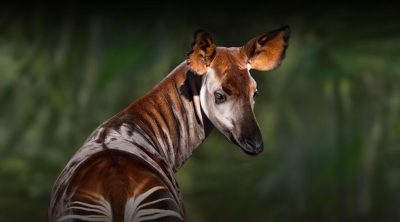
The okapi is a shy animal related to the giraffe. It lives in the dense rainforests of central Africa and eats a diet of leaves and shoots. It was completely unknown until 1900.
The okapi’s home is in the tropical rainforest in the northeast region of the Democratic Republic of the Congo (formerly Zaire), in Central Africa. Why does the okapi have zebra-like stripes? These markings, which seem very bold to us, offer great camouflage when an okapi stands in the partial sunlight that filters through its dense rainforest habitat. The stripes may also help a young okapi follow its mother through the dark forest, and they may help adults find each other, too. The okapi’s dark purplish or reddish brown fur is dense and feels like velvet. It’s also oily, so water slides right off, keeping the okapi dry on rainy days. Only male okapi have horns, which are covered by skin, short, and slant backward so they won’t get tangled in forest branches.
If okapis are related to giraffes, why aren’t they as tall as giraffes? In a rainforest, there are trees with branches hanging down, as well as roots and tree trunks to dodge. Okapis need to have shorter legs and necks to help them swerve around these obstacles. Being really tall is not a good idea in a forest!
Okapis often travel up to 0.5 miles (0.8 kilometers) a day in search of food, usually along trails worn down by generations of okapis. They are generally solitary, unless an adult female has a calf with her. Adult males have home ranges that cover more area, and they can travel up to 2.5 miles (4 kilometers) a day. The males try to keep other males out of their territories but allow females to travel through in search of food.
Both male and female okapis are most active during the afternoon through the evening. They are important forest browsers, eating 40 to 65 pounds (18 to 29 kilograms) of leaves, twigs, and fruits each day and leaving a “pruning line” in the foliage. Okapis use their prehensile tongue to get food by pulling leaves from trees and into their mouth. The tongue is also an important grooming tool, helping to keep the velvety soft, short coat in tip-top shape. Okapis have also been seen eating clay and burnt charcoal, probably for minerals. And just like giraffes, sheep, and goats, okapis are ruminants.
Credit : San Diego Zoo
Picture Credit : Google




